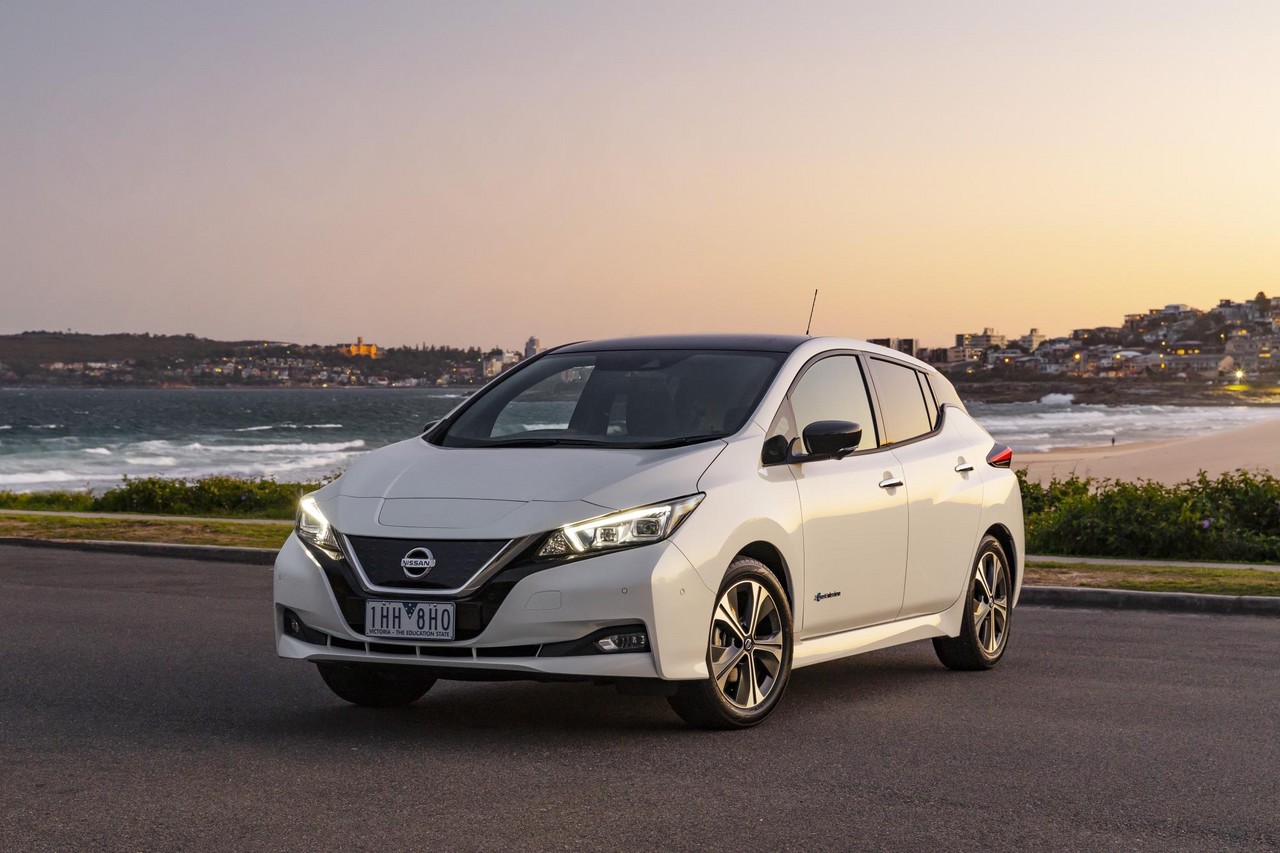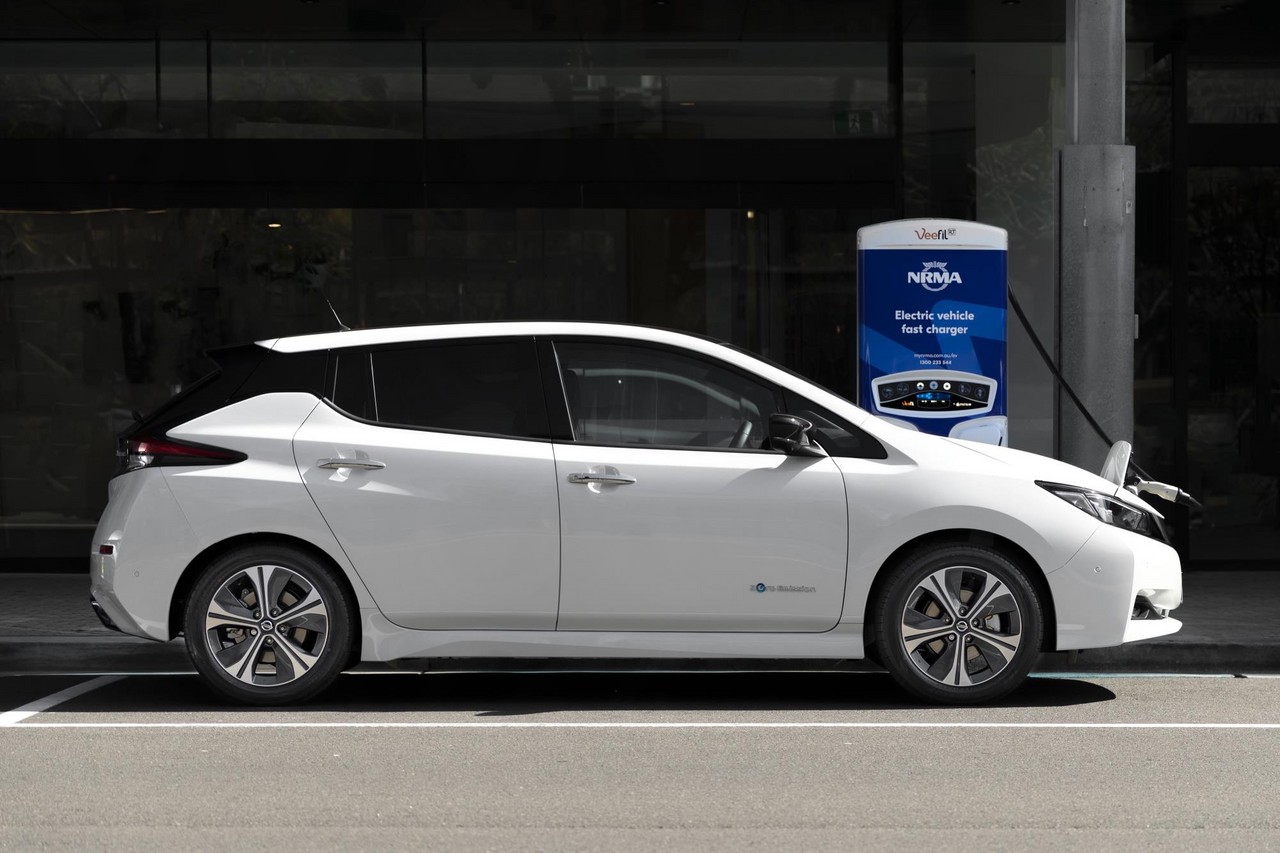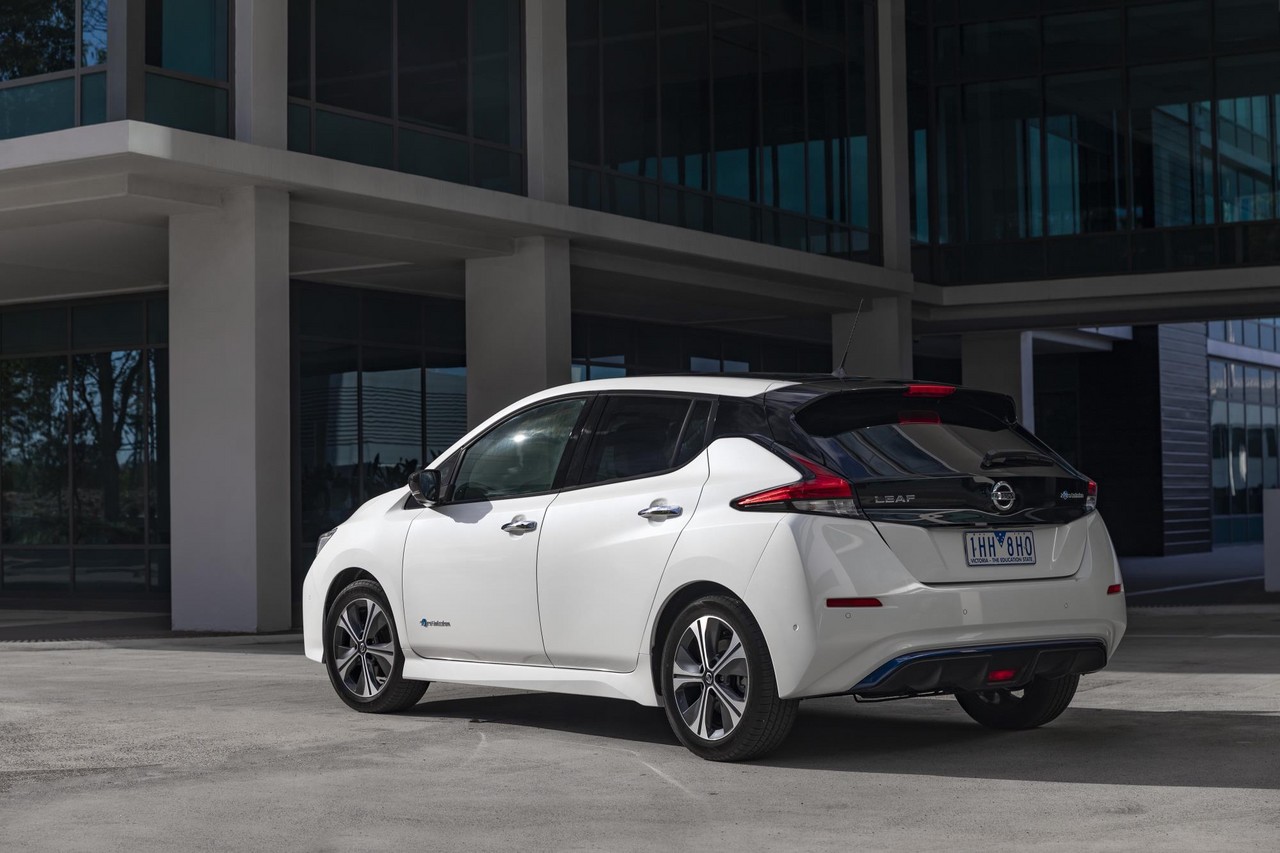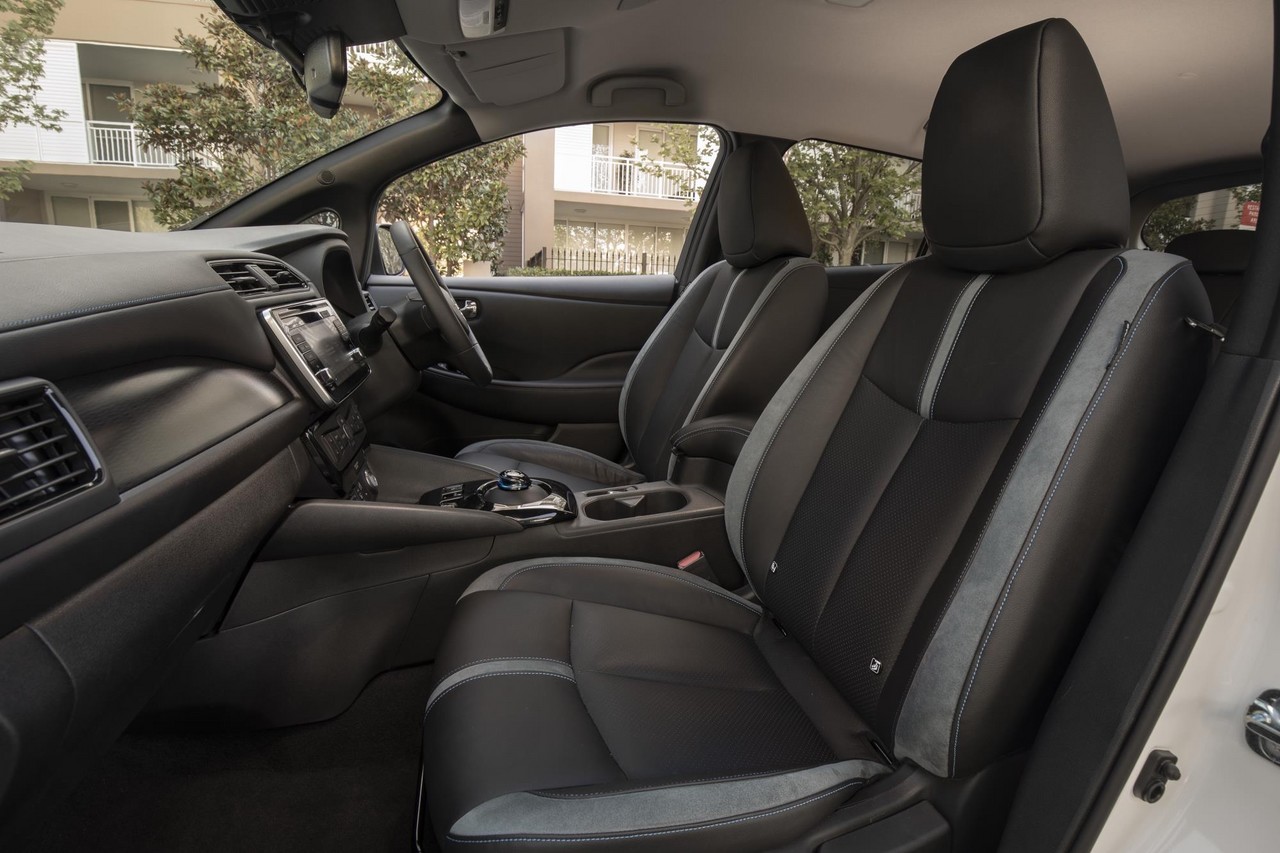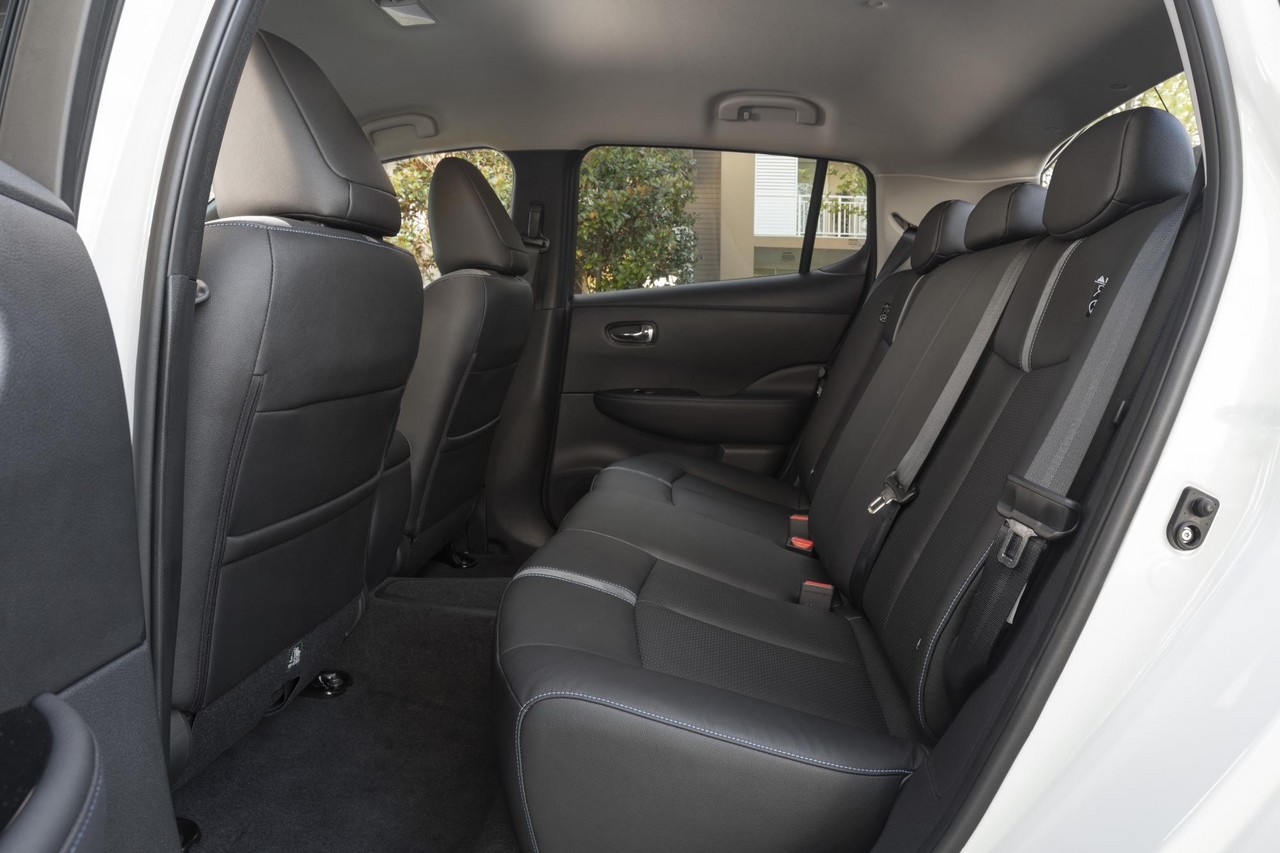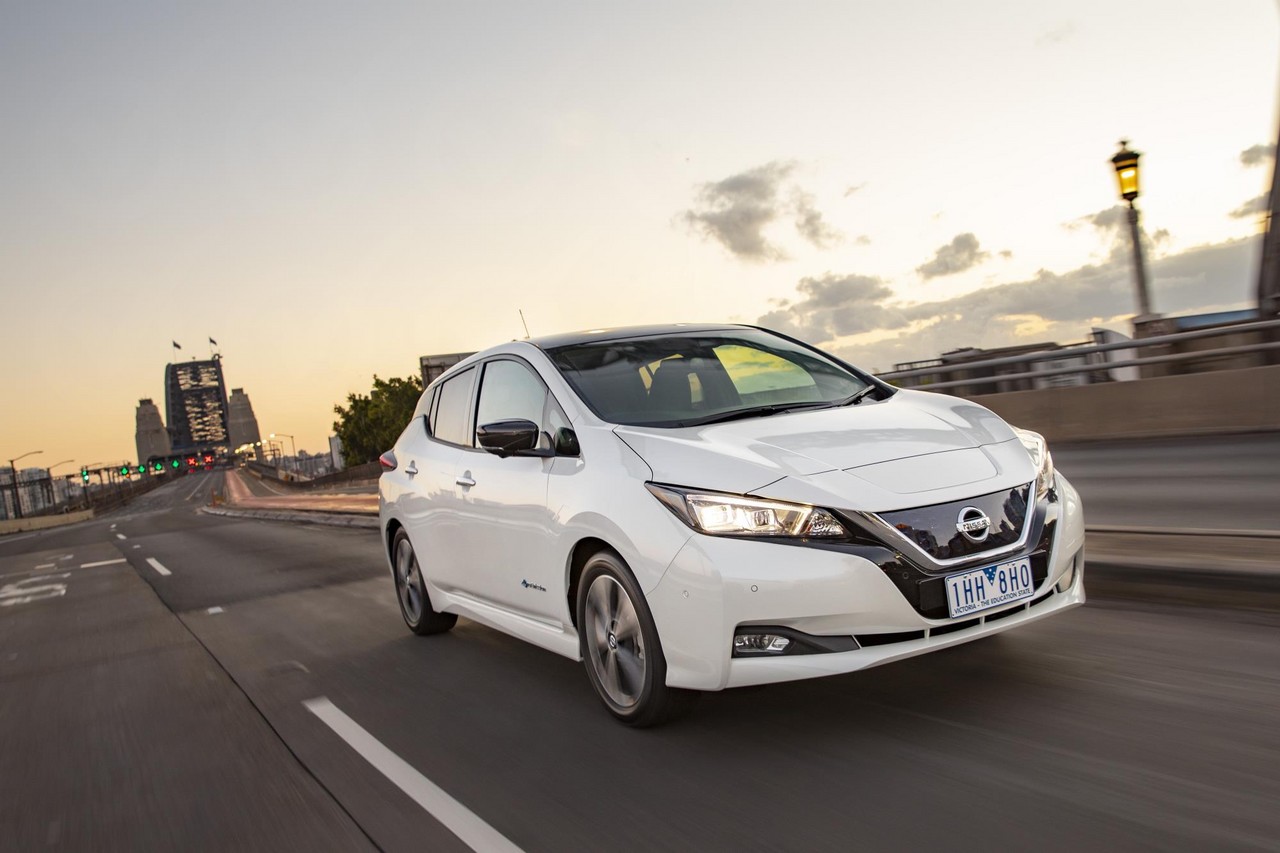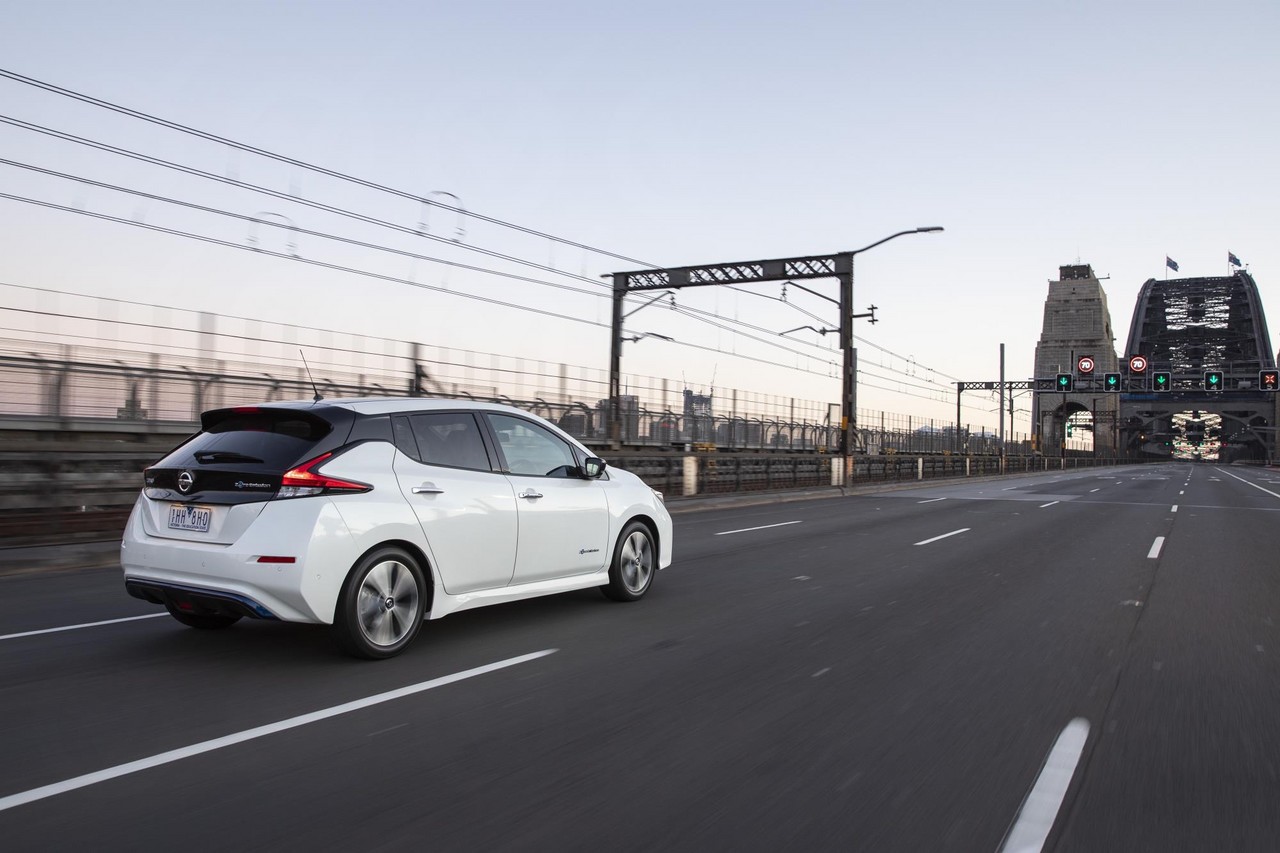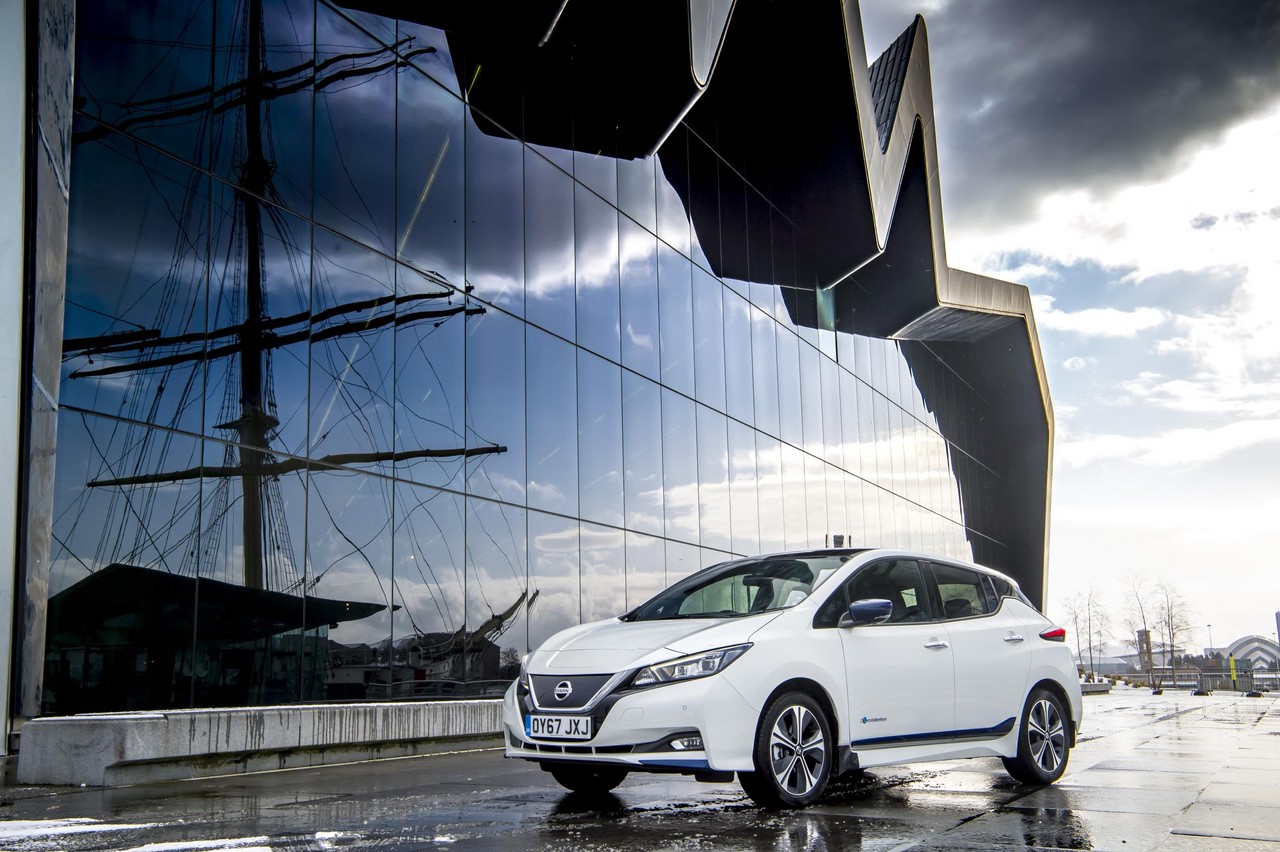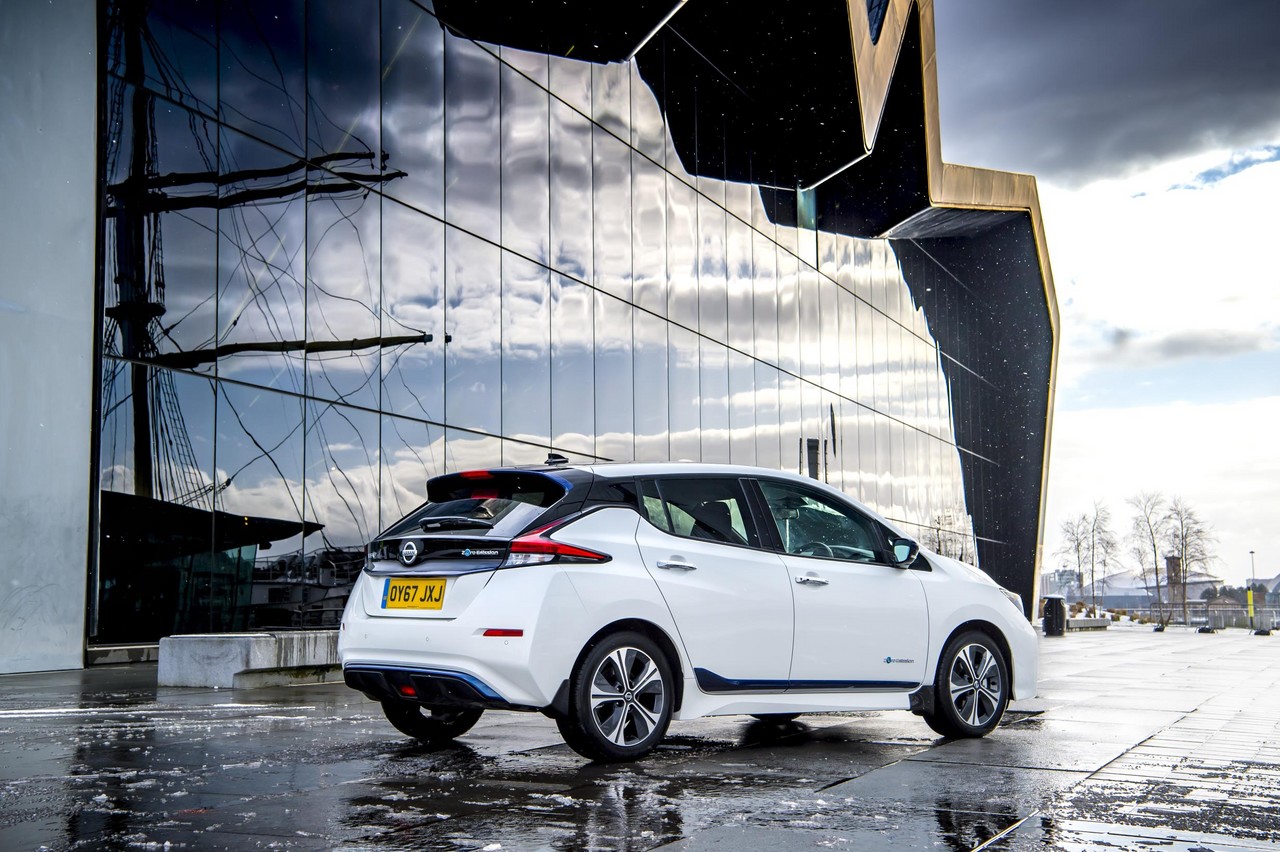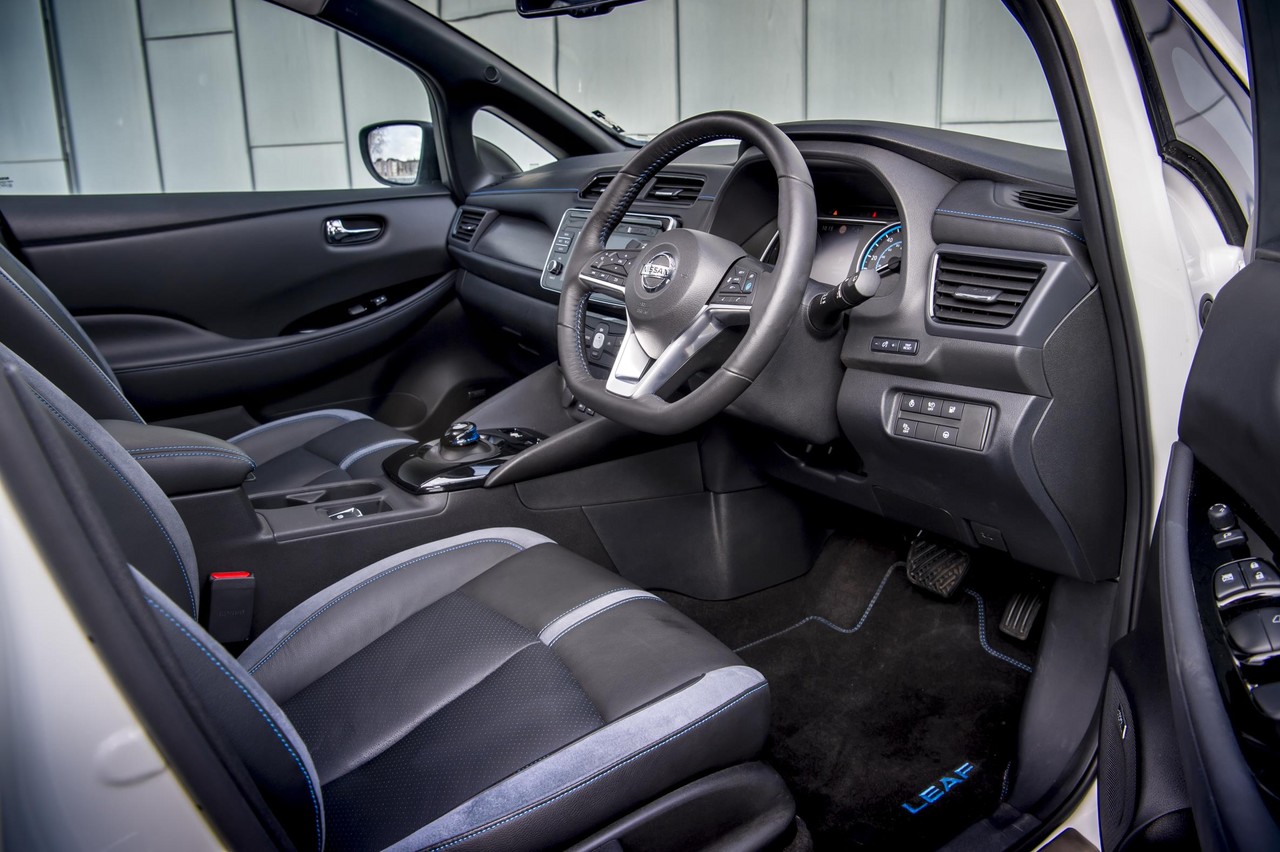
- Quiet and refined driving experience
- 270 km range (WLTP standard) adequate for daily drives
- Five star Euro NCAP safety rating
- Comfortable ride
- Steering is light and accurate…
- … but lacks feedback
- High driving position and steering column lacks telescopic adjustment
- Interior fit and finish doesn’t match the retail price
- High retail price: $49,990 plus on-road costs
Overview
Production of the Nissan ZE1 Leaf commenced in October 2017 and Australian deliveries commenced in August 2019. Manufactured in Yokosuka, Japan, the front-wheel drive Nissan ZE1 Leaf was a five-door hatchback that was powered by an electric motor. For Australia, the Nissan ZE1 Leaf was launched with a recommended retail price of $49,990 (excludes on-road costs).
Electric motor
The Nissan ZE1 Leaf was powered by an AC synchronous motor which produced 110 kW and 320 Nm. The electric motor drew power from a laminated 40 kWh lithium-ion battery that had 24 modules, each containing eight cells. Drive was transmitted to the front wheels via a single speed reduction gear, and the ZE1 Leaf could accelerate from rest to 100 km/h in 7.9 seconds. The ZE1 Leaf had driving ranges of 270 km and 315 km under the WLTP and NEDC standards, respectively.
Charging
The Nissan ZE1 Leaf could be charged in three ways:
- Using a Mode 2 cable to charge via a standard three-pin 15A 240V wall socket. Using this method, the battery could be fully charged in approximately 24 hours;
- Using a Mode 3 cable with a dedicated EVSE plug to connect to an AC charger (the Nissan Leaf was supplied with such a cable). Using this method, the battery could be recharged in 7.5 hours; and,
- Using a 50 kWh CHAdeMO DC fast charging point (available along some highways). With this method, the battery could be charged to 80 per cent capacity in approximately 60 minutes.
| Motor | Trans. | Peak power | Peak torque |
|---|---|---|---|
| AC synchronous electric motor | 1sp direct drive | 110 kW at 3283-9795 rpm | 320 Nm at 0-3283 rpm |
Drive modes and e-Pedal
The Nissan ZE1 Leaf had four drive modes:
- D Mode: for a ‘responsive’ drive and maximum performance;
- B Mode: maximum regenerative braking to increase driving range;
- Eco Mode: limits engine outputs to reduce energy use by about 10 per cent; and,
- B+ Eco Mode: maximum regenerative braking, disconnection of energy intensive systems and limited engine output. According to Nissan, total energy use could be reduced by up to 30 per cent.
The Nissan ZE1 Leaf had an ‘e-Pedal’ which enabled the driver to start, accelerate, decelerate and stop by increasing or decreasing pressure on the accelerator pedal. When the accelerator was fully released, regenerative and friction brakes were applied automatically, bringing the car to a complete stop. The Nissan Leaf would then hold its position, even on uphill slopes, until the accelerator was pressed again.
Body and dimensions
Compared to the Nissan ZE0 Leaf which preceded it, the ZE1 Leaf was 50 mm longer (at 4490 mm), 20 mm wider (1790 mm) and 9 mm lower (1540 mm), while wheelbase length (2700 mm) is unchanged; its drag co-efficient was 0.28 Cd. Cargo space was 405 litres (VDA method) with the rear seats in position, though this increased to 1176 litres when the rear seats were folded down and luggage was filled to the roofline.
The Nissan ZE1 Leaf had a kerb weight of 1594 kg.
Suspension
The Nissan ZE1 Leaf had MacPherson strut front suspension and a torsion beam rear axle. For improved compliance, the rear suspension for the ZE1 Leaf had rubber bump stops (rather than urethane bump stops as per the ZE0 Leaf).
The ZE1 Leaf was equipped with Nissan’s ‘Intelligent Ride Control’ which would effect a small amount of braking when going over bumps to reduce pitch – this provided faster dampening of the pitch motion that a vehicle using shock absorbers alone.
Steering
TheThe Nissan ZE1 Leaf had rack-and-pinion steering with electric power assistance; the steering wheel required 2.7 turns from lock to lock.
Safety equipment
Standard safety equipment for the Nissan ZE1 Leaf consisted of dual front airbags, front seat-mounted airbags, full-length curtain airbags (i.e. for front and rear occupants), ABS, electronic brake force distribution, electronic stability control, traction control and front seatbelts with pre-tensioners and load limiters.
As standard, the Nissan ZE1 Leaf was equipped with the following active safety technologies –
- Forward Collision Warning (FCW): used a radar sensor to detect traffic and pedestrian in front of the vehicle. If the distance to the vehicle ahead decreased such that there was a risk of collision, an audible warning would be emitted and a visual signal would appear on the instrument panel;
- Intelligent Emergency Braking: if the driver did not respond to the Forward Collision Warning System, the brakes would be applied automatically to reduce vehicle speed so that the collision could be avoided or its severity reduced;
- Intelligent Lane Intervention: could apply steering wheel torque to maintain the Leaf’s position within its lane. Furthermore, the system provided visual and audible alerts if the Leaf was drifting into another lane;
- Blind Spot Warning: used two radar sensors in the rear bumper to detect vehicles in the driver’s blind spot. If a vehicle was in the blind spot and the driver indicates a lane change, a light would flash in the door mirror on that side of the vehicle and a warning tone would sound;
- Rear Cross Traffic Alert: used the rear radar sensors to detect approaching traffic that may cross the driver’s path as they are reversing. If detected, the driver would be alerted via visual and audible warnings;
- Intelligent Driver Alert: monitored driver behaviour and, after learning the driver’s particular style, monitored steering inputs. If erratic steering – a common sign of fatigue – was detected, then a dashboard alert would appear to recommend that the driver take a break; and,
- Traffic Sign Recognition: could interpret traffic sign information and relay this information to the driver via the central touchscreen and digital instrument display.
Euro NCAP testing
In Euro NCAP testing , the Nissan ZE1 Leaf received a five star safety rating which included a 93 per cent adult occupant protection rating and an 86 per cent child occupant protection rating. In the frontal offset test, occupant protection for the driver’s head, chest and lower legs was rated as adequate (i.e. a slight risk of serious injury), while neck, thigh and foot protection was rated as good. Maximum points, however, were awarded in the side impact and pole tests.
Features: Nissan ZE1 Leaf
The infotainment system for the Nissan ZE1 Leaf consisted of an 8.0-inch touchscreen, satellite navigation, a Bose audio system with seven speakers, digital radio tuner, Bluetooth mobile phone connectivity and audio streaming, voice recognition and Apple CarPlay and Android Auto smartphone integration.
Beyond this, standard features for the Nissan Leaf included 17-inch alloy wheels with 215/50 R17 tyres, black leather-accented seats with ‘ultrasuede’ inserts, a six-way manually adjustable driver’s seat, climate control air conditioning, heated seats (front and rear), LED headlights, LED daytime running lights, front fog lights, dusk-sensing headlights, rain-sensing wipers, front and rear parking sensors, a leather steering wheel with heating, 60:40 split rear seats, remote central locking with proximity key, power adjustable and heated door mirrors with folding function, power windows, an auto-dimming rear view mirror, tilt steering column adjustment, push-button start, rear privacy glass, seven-inch instrument cluster display with analogue speedometer, tyre pressure monitoring, a trip computer and immobiliser.
The Nissan ZE1 Leaf was also equipped with:
- Nissan’s Intelligent Around-View Monitor with Moving Object Detection which used four cameras (in the front grille, rear tailgate and door mirrors) to produce a bird’s eye view of the vehicle that was shown on central touchscreen. Moving Object Detection provided visual and audible warnings if an object was detected in front or behind the vehicle; and,
- High Beam Assist which used a high resolution camera to detect lighting conditions and oncoming traffic. Based on this information, the system would use or dip the high beams to avoid dazzling other drivers.
The Nissan ZE1 Leaf was available in six paint finishes: Arctic White, Ivory Pearl (with a black roof), Magnetic Red, Pearl Black, Platinum and Gun Metallic.
